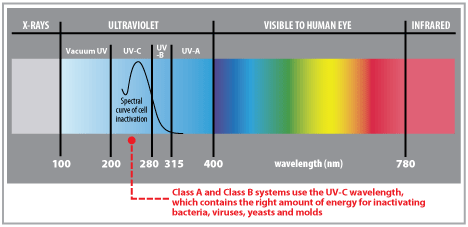
Should I Buy Class A or Class B? What's the Difference?
NSF/ANSI 55 separates UV water purification systems into two distinct classes. Class A UV water systems should be used with well or surface water (streams, lakes, etc.) and are designed to inactivate and/or remove microorganisms, including bacteria, viruses, Cryptosporidium oocysts and Giardia cysts from contaminated water. Class A UV systems are not intended for the treatment of water with an obvious contamination or intentional source, such as raw sewage, nor are they intended to convert wastewater to drinking water. They are intended to be installed on visually clear (not colored, cloudy or turbid) water.
Class B UV water systems, on the other hand, should be used with municipal water or treated water and are designed for supplemental bactericidal treatment of disinfected public drinking water, or other drinking water that has been tested and deemed acceptable for human consumption by the state or local health agency having jurisdiction. Class B UV systems are designed to reduce normally occurring, nonpathogenic nuisance microorganisms only. These systems are not intended for the disinfection of microbiologically unsafe water and may not make individual or general cyst claims. Microbiological health effects claims may not be made on Class B systems.
UV dosage is the measurement of energy delivered by UV water systems, typically measured in mJ/cm². The more dosage provided, the more energy delivered to any microorganisms present in the treated water. At a certain threshold, this energy becomes sufficient to inactivate most of the microorganisms present.
style="text-align: center;"
NSF/ANSI Standard 55 requires that Class A UV systems deliver a high enough UV dose at 254 nm (40 mJ/cm²) to inactivate the pathogenic microorganisms that could be responsible for spreading disease through contamination of drinking water. Class B systems are required to deliver a lesser dose of 16 mJ/cm² sufficient enough to inactivate nonpathogenic organisms.
This dosage is verified through a test procedure detailed in the Standard. The test must be conducted at the highest achievable flow rate through the system, with UVT reduced to 70 percent or to the alarm set point, whichever is lower.
Alarm or Fail SafeNSF/ANSI 55 requires that Class A UV systems have alarm and/or fail-safe design elements incorporated into them. Specifically, Class A systems must include a UV sensor since a visible sensor is not sufficient according to the Standard. The UV sensor must be connected to an alarm, which provides visual and audible indication that the system is not performing and/or terminates the discharge of treated water. The Standard includes a test to ensure that the UV sensor and alarm perform properly in low-dosage conditions. Although Class B systems are not required to have a UV sensor, if they are so equipped, the sensor must meet the necessary requirements.
Flow ControlBecause UV dosage is inversely proportional to flow rate through the system, NSF/ANSI 55 requires that UV systems include automatic, fixed flow-rate controls to prevent excessive flow over the manufacturer's recommended operating pressure range. The Standard requires that the flow rate of the system be evaluated over the manufacturer's operating pressure range and up to at least 100 psi (690 kPa), and that the Standard testing for UV dosage must be conducted at the highest flow rate achieved by the system.
Basic Requirements of NSF/ANSI 55 for Point-of-Use or Point-of-Entry UV Systems| CLASS A | CLASS B | |
| USE | Well or surface water (stream, lake, etc.) | Municipal water or treated water |
| UV Dosage | 40 mJ/cm² at highest achievable flow rate with flow control in place, with UVT reduced to alarm set point or 70%, whichever is lower | 16 mJ/cm² at highest achievable flow rate with flow control in place, with UVT reduced to 70% |
| UV Sensor | Required | Not required |
| Alarm (visual, audible, termination of treated water) | Required | Not required |
| Flow Control | Required | Required |




